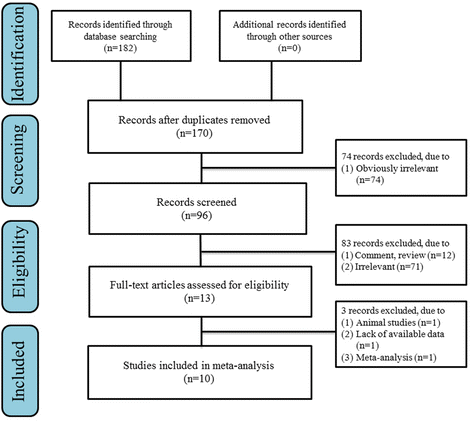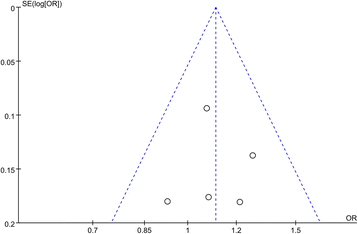Collagen IX gene polymorphisms and lumbar disc degeneration: a systematic review and meta-analysis
- PMID: 29506578
- PMCID: PMC5838857
- DOI: 10.1186/s13018-018-0750-0
Collagen IX gene polymorphisms and lumbar disc degeneration: a systematic review and meta-analysis
Abstract
Background: An increasing number of studies have investigated associations between collagen IX alpha 2 chain (COL9A2) and collagen IX alpha 3 chain (COL9A3) gene polymorphisms and the risk of lumbar disc degeneration (LDD). However, these studies have yielded contradictory results. The purpose of this meta-analysis is to investigate the association between the collagen IX gene polymorphisms (rs12077871, rs12722877, rs7533552 in COL9A2; rs61734651 in COL9A3) and LDD.
Methods: All relevant articles were collected from PubMed, Web of Science, and China National Knowledge Infrastructure (CNKI). The last electronic search was performed on September 1, 2017. The allele/genotype frequencies were extracted from each study. The odds ratio (OR) and 95% confidence interval (CI) were used to assess the strength of associations under the five comparison genetic models. Statistical analysis was performed by Review Manager (RevMan) 5.31 software.
Results: The meta-analysis of 10 case-control studies, including 2102 LDD cases and 2507 controls, indicated that COL9A2 gene (rs12077871, rs12722877, rs7533552) and COL9A3 gene (rs61734651) polymorphisms were not associated with LDD (rs12077871: T vs. C, OR = 1.85, 95% CI = 0.87-3.91, P = 0.11; rs12722877: G vs. C, OR = 0.83, 95% CI = 0.69-1.01, P = 0.06; rs7533552: G vs. A, OR = 1.11, 95% CI = 0.98-1.25, P = 0.09; rs61734651: T vs. C, OR = 1.57, 95% CI = 0.51-4.84, P = 0.43). The Egger text and the Begg funnel plot did not show any evidence of publication bias.
Conclusion: rs12077871, rs12722877, and rs7533552 variants in COL9A2 and rs61734651 variant in COL9A3 were not significantly associated with a predisposition to LDD. Large-scale and well-designed studies are needed to confirm this conclusion.
Keywords: COL9A2; COL9A3; Lumbar disc disease; Meta-analysis; Polymorphisms.
Conflict of interest statement
Ethics approval and consent to participate
Not applicable.
Consent for publication
Not applicable.
Competing interests
The authors declare that they have no competing interests.
Publisher’s Note
Springer Nature remains neutral with regard to jurisdictional claims in published maps and institutional affiliations.
Figures






Similar articles
-
Meta-analysis of the association between COL9A2 genetic polymorphisms and lumbar disc disease susceptibility.Spine (Phila Pa 1976). 2014 Sep 15;39(20):1699-706. doi: 10.1097/BRS.0000000000000497. Spine (Phila Pa 1976). 2014. PMID: 24983932
-
Vitamin D receptor gene polymorphisms and lumbar disc degeneration: a systematic review and meta-analysis.Eur Spine J. 2017 Jan;26(1):267-277. doi: 10.1007/s00586-016-4771-2. Epub 2016 Sep 9. Eur Spine J. 2017. PMID: 27613009
-
Association of VDR Polymorphisms (FokI, ApaI, and TaqI) with Susceptibility to Lumbar Disc Herniation: Systematic Review, Meta-Analysis, Trial Sequential Analysis, and Transcriptional Prediction.Medicina (Kaunas). 2025 May 12;61(5):882. doi: 10.3390/medicina61050882. Medicina (Kaunas). 2025. PMID: 40428840 Free PMC article. Review.
-
Psychological and/or educational interventions for the prevention of depression in children and adolescents.Cochrane Database Syst Rev. 2004;(1):CD003380. doi: 10.1002/14651858.CD003380.pub2. Cochrane Database Syst Rev. 2004. Update in: Cochrane Database Syst Rev. 2011 Dec 07;(12):CD003380. doi: 10.1002/14651858.CD003380.pub3. PMID: 14974014 Updated.
-
Selenium for preventing cancer.Cochrane Database Syst Rev. 2018 Jan 29;1(1):CD005195. doi: 10.1002/14651858.CD005195.pub4. Cochrane Database Syst Rev. 2018. PMID: 29376219 Free PMC article.
Cited by
-
Association between polymorphisms of collagen genes and susceptibility to intervertebral disc degeneration: a meta-analysis.J Orthop Surg Res. 2021 Oct 18;16(1):616. doi: 10.1186/s13018-021-02724-8. J Orthop Surg Res. 2021. PMID: 34663366 Free PMC article. Review.
-
Genetic Predictors of Early-Onset Spinal Intervertebral Disc Degeneration: Part One of Two.Cureus. 2021 May 22;13(5):e15182. doi: 10.7759/cureus.15182. Cureus. 2021. PMID: 34178503 Free PMC article. Review.
-
Evidence from Mendelian randomization analysis combined with meta-analysis for the causal validation of the relationship between 91 inflammatory factors and lumbar disc herniation.Medicine (Baltimore). 2024 Nov 22;103(47):e40323. doi: 10.1097/MD.0000000000040323. Medicine (Baltimore). 2024. PMID: 39809179 Free PMC article.
-
The Role of Polymorphisms in Collagen-Encoding Genes in Intervertebral Disc Degeneration.Biomolecules. 2021 Aug 26;11(9):1279. doi: 10.3390/biom11091279. Biomolecules. 2021. PMID: 34572492 Free PMC article. Review.
-
A novel missense COL9A3 variant in a pedigree with multiple lumbar disc herniation.J Orthop Surg Res. 2024 Jan 3;19(1):19. doi: 10.1186/s13018-023-04481-2. J Orthop Surg Res. 2024. PMID: 38166944 Free PMC article.
References
-
- Joud A, Petersson IF, Englund M. Low back pain: epidemiology of consultations. Arthritis Care Res (Hoboken) 2012;64:1084–1088. - PubMed
Publication types
MeSH terms
Substances
Grants and funding
LinkOut - more resources
Full Text Sources
Other Literature Sources
Medical

